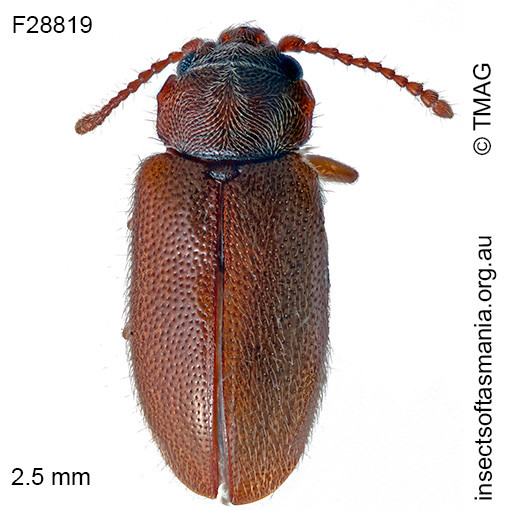
Boganium armstrongi (a species of bogan-beetle)
Basis for Tasmanian occurrence
TMAG collections
Classification
Suborder: Polyphaga
Superfamily: Cucujoidea
Family: Boganiidae
Subfamily: Boganiinae
Tribe: Boganiini
Morphology
Flightedness: winged and assumed capable of flight
Source literature on morphology and taxonomy (*primary taxonomic source, where identified):
*Sen Gupta, T. & Crowson, R.A. (1966). A new family of cucujoid beetles, based on six Australian and one New Zealand genera. Ann. Mag. Nat. Hist. 9: 61-85.
Ecology
Association with dead wood or old trees: at least facultatively saproxylic
Ecological attributes: — May occupy logs or trunks of Eucalyptus obliqua, at least temporarily, since found having emerged within six years of felling (Grove et al., 2009).
Collection method(s) for TMAG material: — Emergence trapping from log of Eucalyptus obliqua — Knockdown fogging of canopy of Eucalyptus obliqua — Malaise trapping — Trapping using a range of devices placed in crown of Eucalyptus obliqua (Bar-Ness, 2005).
Source ecological literature:
Bar-Ness, Y. (2005). Crown structure and the canopy arthropod biodiversity of 100 year old and old-growth Tasmanian Eucalyptus obliqua. Msc thesis, Univ. of Tasmania, Hobart.
Grove, S. et al. (2009). A long-term experimental study of saproxylic beetle … succession in Tasmanian Eucalyptus … logs… In: Fattorini, S. (Ed.), Insect Ecology and Conservation. Research Signpost, pp. 71-114.
Yee, M. (2005). The ecology and habitat requirements of saproxylic beetles native to Tasmanian wet eucalypt forests: potential impacts of commercial forestry practices. PhD thesis, Univ. of Tasmania, Hobart.


